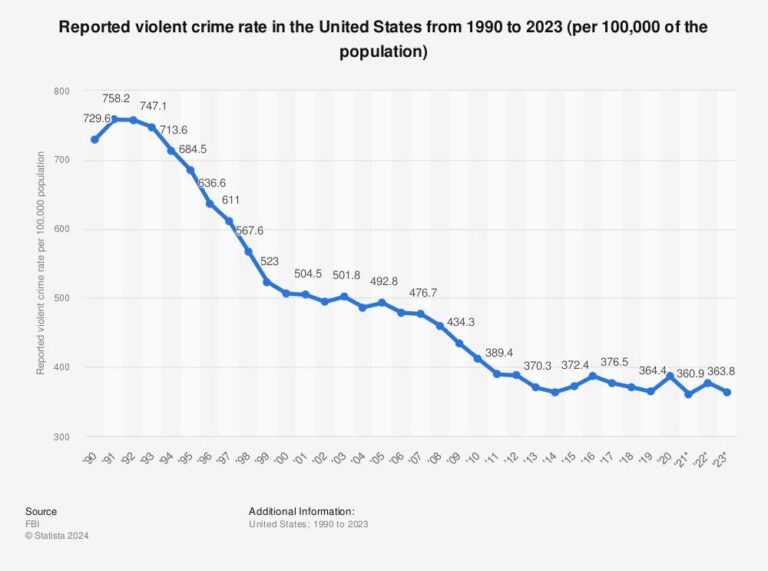Transforming Trends: The Changing Face of Violent Crime in America
Unexpected Declines in Violent Crime Across Major US Cities
After a prolonged period marked by rising violent crime rates, recent statistics reveal a surprising downturn in several prominent metropolitan areas. Cities such as Chicago, Los Angeles, and New York have experienced measurable reductions in violent offenses, defying earlier predictions by criminologists and analysts. This emerging pattern suggests that innovative community programs and strategic policy reforms may be beginning to take effect, reshaping the urban crime environment in significant ways.
Several critical elements appear to be driving this positive change:
- Implementation of advanced, data-centric policing methods
- Expanded youth-focused community outreach initiatives
- Economic revitalization efforts targeting unemployment in vulnerable neighborhoods
- Broadened access to mental health care and social support services
| City | Violent Crime Rate (2023) | Year-over-Year Change (2022-2023) |
|---|---|---|
| Chicago | 520 per 100,000 | -9% |
| Los Angeles | 430 per 100,000 | -6% |
| New York | 340 per 100,000 | -8% |
Decoding the Drivers Behind the Decline in Violent Crime
The downturn in violent crime rates is the result of a multifaceted interplay between social, economic, and technological factors. Investments in education and mental health services have been instrumental, alongside reforms in policing that emphasize community trust-building over confrontation. Demographic trends, including an aging population and shifts in urban residency, also contribute to this decline, as younger demographics—traditionally linked to higher crime rates—diminish in proportion.
Technological advancements have further revolutionized crime prevention. Tools such as real-time crime analytics, predictive policing algorithms, and enhanced surveillance systems enable law enforcement to deploy resources more efficiently. Additionally, the rise of social media and public demand for transparency have pressured agencies to adopt more progressive and accountable practices. Key contributors to this transformation include:
- Policy Innovations: Emphasis on community policing and sentencing reforms
- Economic Improvements: Job creation and poverty alleviation programs
- Demographic Shifts: Aging populations and migration trends
- Technological Integration: Crime mapping and data-driven decision-making
- Social Change: Evolving public attitudes and increased civic participation
| Influencing Factor | Degree of Impact | Illustrative Example |
|---|---|---|
| Education Investment | High | Rising high school graduation rates |
| Police Reform | Medium | Mandatory body-worn cameras |
| Neighborhood Renewal | Medium | Opening of new community hubs |
| Technological Tools | High | Deployment of AI-driven crime prediction |
Community Impact and Evolving Policing Approaches
The shifting crime landscape presents both challenges and opportunities for communities and law enforcement agencies. In areas historically burdened by violence, grassroots movements have emerged, focusing on strengthening social ties and providing support systems that address underlying causes of crime. These efforts highlight the critical link between community well-being and sustainable public safety.
Law enforcement is concurrently adapting by embracing intelligence-led policing strategies that prioritize proactive measures over reactive enforcement. This includes:
- Focused surveillance in identified high-crime zones
- Partnerships with local nonprofits and civic groups
- Specialized training in crisis management and de-escalation techniques
| Policing Strategy | Main Objective | Effect on Community |
|---|---|---|
| Community-Oriented Policing | Fostering mutual trust | Enhanced collaboration |
| Hotspot Enforcement | Targeted crime suppression | Reduced incidents in critical areas |
| Crisis Response Training | Conflict de-escalation | Lower rates of violent encounters |
Strategic Policy Recommendations for Long-Term Crime Reduction
To sustain and build upon recent progress, a comprehensive policy framework is essential. Prioritizing funding for community-driven programs that bridge gaps between law enforcement and residents—especially in marginalized neighborhoods—remains crucial. Integrating social services with policing efforts addresses root causes such as economic disparity, educational deficits, and mental health challenges.
Moreover, expanding the use of data analytics and predictive tools can enhance targeted interventions while minimizing risks of bias. Experts advocate for the following key policy initiatives to maintain downward crime trends:
- Broaden youth mentorship and engagement programs to steer vulnerable individuals away from criminal pathways
- Enhance transparency through accessible public crime data and accountability frameworks
- Integrate mental health resources within community outreach and crisis response
- Boost economic development efforts in neighborhoods with elevated crime rates
- Expand officer training focused on cultural sensitivity and conflict resolution
| Policy Focus | Representative Program | Anticipated Outcome |
|---|---|---|
| Community Engagement | After-school mentorship initiatives | Reduced repeat offenses |
| Transparency | Interactive crime data portals | Strengthened public trust |
| Mental Health | Mobile crisis intervention teams | Decreased emergency incidents |
| Economic Empowerment | Vocational training partnerships | Higher employment rates |
| Law Enforcement Training | De-escalation and cultural competency workshops | Fewer violent confrontations |
Looking Ahead: Navigating the Future of Violent Crime in the US
The evolving dynamics of violent crime in the United States underscore the necessity for continuous evaluation and adaptive strategies. While recent declines offer hope, the multifaceted nature of crime requires sustained commitment from policymakers, law enforcement, and communities. Staying abreast of emerging trends and embracing holistic, data-informed approaches will be vital in fostering safer, more resilient neighborhoods nationwide.








